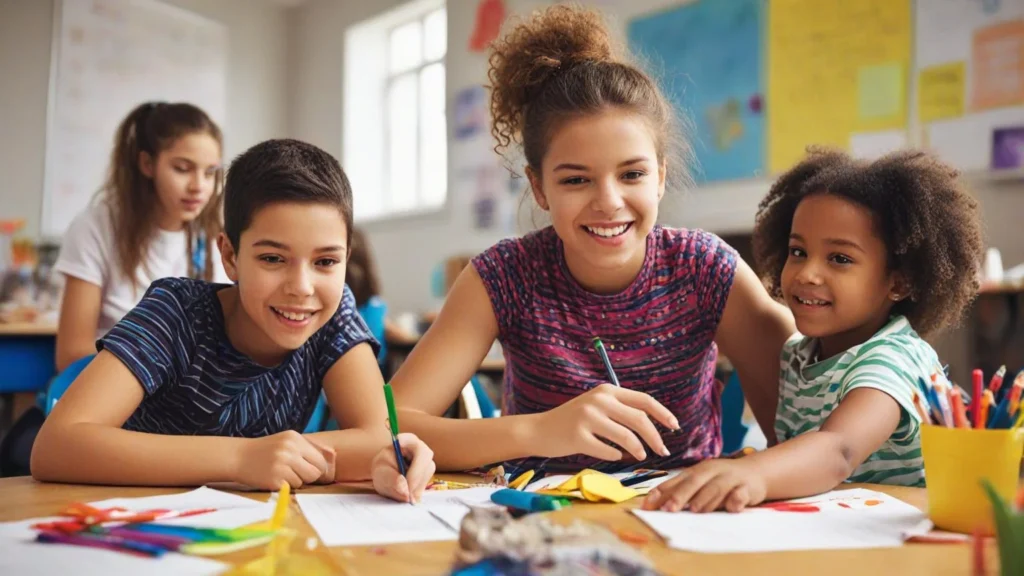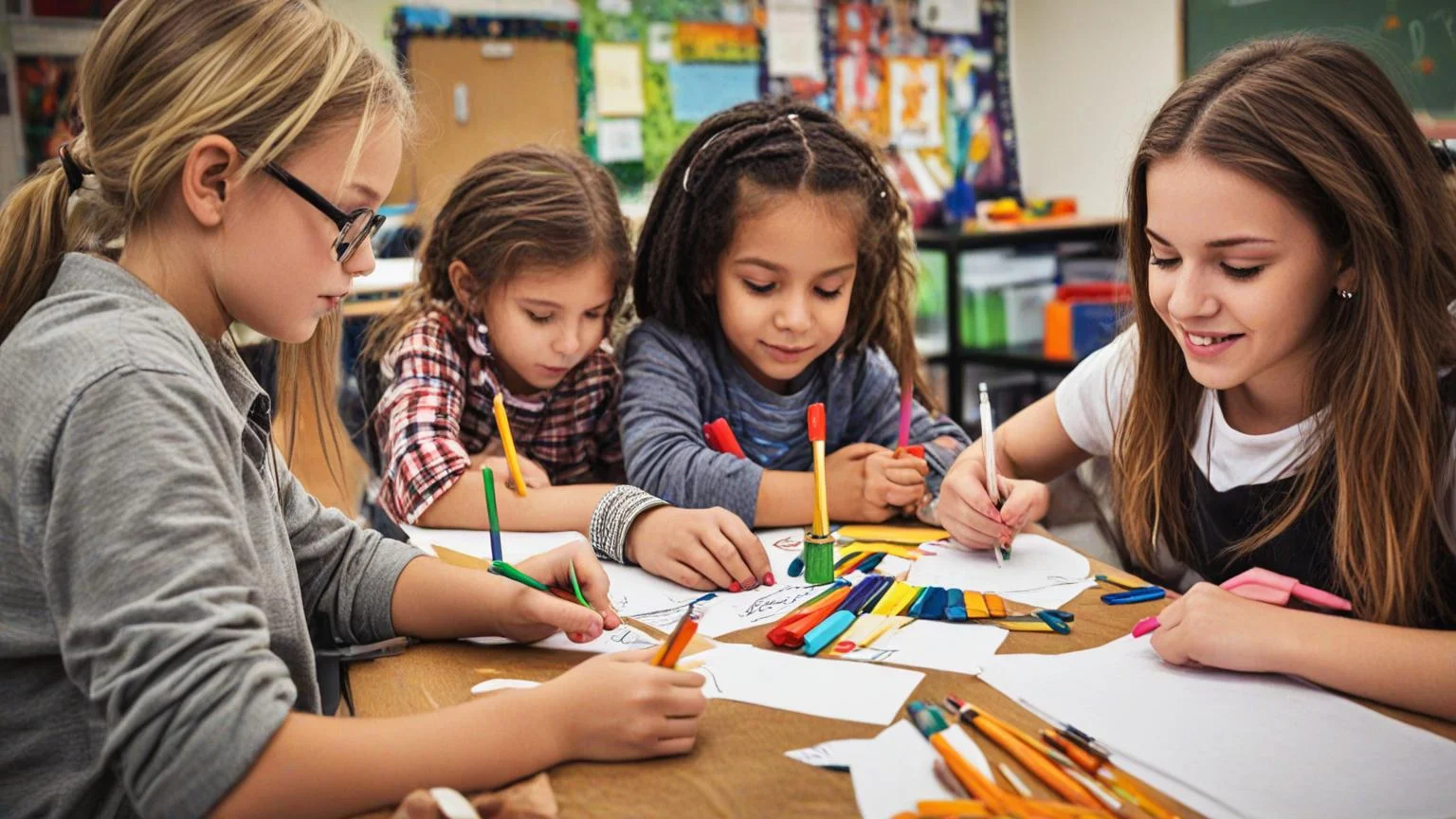Creativity is a vital skill that extends beyond the arts into all areas of life and learning. In the classroom, fostering creativity can enhance students’ problem-solving abilities, critical thinking skills, and overall engagement with the material. This article explores effective techniques for encouraging creativity, providing practical strategies for teachers to implement in their classrooms.
How to Foster Creativity in a Classroom
Fostering creativity in the classroom involves creating an environment where students feel safe to express their ideas, explore new concepts, and take risks. Here are several methods to achieve this:
Create a Supportive Environment
What It Is: A classroom environment that encourages experimentation and values diverse ideas.
How to Do It:
- Encourage Open Dialogue: Allow students to share their ideas without fear of judgment.
- Celebrate All Ideas: Show appreciation for all contributions, whether they succeed or fail.
- Provide Creative Spaces: Set up areas in the classroom for brainstorming and creative activities.
Benefits: A supportive environment helps students feel confident in sharing their ideas and fosters a culture of creativity.
Example Activities:
- Idea Boards: A space where students can post their creative ideas and get feedback.
- Creative Workstations: Stations with materials for drawing, writing, and building.
Incorporate Creative Thinking Exercises
What It Is: Activities designed to stimulate imaginative thinking and problem-solving skills.
How to Do It:
- Brainstorming Sessions: Hold sessions where students generate as many ideas as possible.
- Divergent Thinking Tasks: Engage students in activities that encourage multiple solutions to a problem.
- Creative Writing Prompts: Use prompts to inspire imaginative storytelling and writing.
Benefits: These exercises help students develop creative problem-solving skills and think outside the box.
Example Exercises:
- Brainstorming Ideas: “How many uses can you think of for a paperclip?”
- Divergent Thinking Task: “Design a new invention that solves a common problem.”
Integrate Art and Design into the Curriculum
What It Is: Incorporating visual arts, design, and creative expression into academic subjects.
How to Do It:
- Art Projects: Include art projects related to the subjects being taught.
- Design Challenges: Create challenges where students design models or presentations.
Benefits: Art and design activities engage students in creative thinking and make learning more dynamic.
Example Projects:
- History Art Project: Create a visual representation of a historical event.
- Science Design Challenge: Design a model of a sustainable energy source.
Promote Collaborative Learning
What It Is: Encouraging students to work together on creative projects and problem-solving tasks.
How to Do It:
- Group Projects: Assign projects that require students to work together and share ideas.
- Peer Reviews: Implement systems where students review and provide feedback on each other’s work.
- Team-Building Activities: Engage students in activities that require teamwork and creativity.
Benefits: Collaboration fosters creativity through diverse perspectives and collective brainstorming.
Example Activities:
- Group Brainstorming Sessions: Work on a project where each member contributes different ideas.
- Peer Review Workshops: Students critique and improve each other’s creative work.
Encourage Risk-Taking and Experimentation
What It Is: Allowing students to try new approaches and explore unconventional ideas.
How to Do It:
- Allow for Mistakes: Create an environment where making mistakes is seen as part of the learning process.
- Support Experimental Projects: Encourage students to try out new methods and approaches in their work.
Benefits: Encouraging risk-taking helps students overcome fear of failure and explore innovative ideas.
Example Approaches:
- Trial and Error Activities: Give students problems where they can experiment with different solutions.
- Creative Freedom: Allow students to choose their projects or methods.
Provide Real-World Connections
What It Is: Linking classroom learning to real-world scenarios and problems.
How to Do It:
- Guest Speakers: Invite professionals from creative fields to speak with students.
- Field Trips: Organize trips to museums, galleries, or creative businesses.
- Real-Life Projects: Engage students in projects that address real-world issues.
Benefits: Real-world connections make learning more relevant and inspire students to think creatively about practical applications.
Example Activities:
- Guest Speakers: Arrange for an artist or entrepreneur to discuss their creative process.
- Field Trip: Visit a local museum or design studio.
Offer Choice and Autonomy
What It Is: Allowing students to make choices about their learning and projects.
How to Do It:
- Project Choices: Offer options for different types of projects or topics.
- Flexible Deadlines: Provide flexible deadlines to accommodate students’ creative processes.
Benefits: Autonomy increases student engagement and allows for personalized creative exploration.
Example Options:
- Project Choices: Choose between a research paper, creative project, or presentation.
- Flexible Deadlines: Adjust deadlines based on individual project needs.
What Is the Technique of Fostering Creativity?

One effective technique for fostering creativity is the “Design Thinking” approach. This method encourages creative problem-solving through a structured process:
Design Thinking Process
- Empathize: Understand the needs and challenges of the users.
- Define: Clearly articulate the problem you are trying to solve.
- Ideate: Brainstorm a wide range of ideas and solutions.
- Prototype: Develop simple models or drafts of your ideas.
- Test: Evaluate your prototypes and gather feedback for improvement.
Benefits: Design Thinking helps students approach problems from multiple angles and encourages innovative solutions.
Example Activity:
- Problem: How can we reduce waste in our school cafeteria?
- Process: Use Design Thinking to create and test potential solutions, such as new recycling programs or waste-reduction initiatives.
What Is the Best Way to Foster Creativity?

The best way to foster creativity is to create an environment that encourages exploration, supports experimentation, and values diverse perspectives. A combination of the strategies discussed above will most effectively nurture creativity in the classroom.
Key Elements:
- Supportive Environment: Make sure students feel safe to express their ideas.
- Creative Activities: Provide diverse opportunities for creative expression.
- Collaborative Learning: Encourage teamwork and collective problem-solving.
- Real-World Connections: Connect classroom learning to real-world problems.
How Do You Foster Children with Creativity?
Fostering creativity in children involves creating opportunities for exploration, encouraging their curiosity, and supporting their creative efforts. Here are some ways to nurture creativity in young learners:
Encourage Exploration
How to Do It: Provide children with diverse materials and opportunities to explore their interests.
Benefits: Exploration fosters curiosity and imaginative thinking.
Example: Provide art supplies, building blocks, and science kits.
Support Curiosity
How to Do It: Respond positively to children’s questions and encourage them to seek answers.
Benefits: Supporting curiosity leads to deeper learning and creative thinking.
Example: When a child asks a question, explore the answer together.
Provide Opportunities for Creative Expression
How to Do It: Offer various activities for children to express their creativity.
Benefits: Creative expression helps children develop their unique talents and interests.
Example Activities: Drawing, storytelling, role-playing.
Create a Safe Space for Failure
How to Do It: Teach children that making mistakes is part of the learning process.
Benefits: A safe space for failure encourages risk-taking and experimentation.
Example: Celebrate attempts and efforts, not just successes.
Foster a Growth Mindset
How to Do It: Encourage children to see challenges as opportunities to grow.
Benefits: A growth mindset supports resilience and creativity.
Example: Praise effort and perseverance instead of just results.
Conclusion
Fostering creativity in the classroom is essential for developing students’ problem-solving skills, critical thinking, and overall engagement in learning. By creating a supportive environment, incorporating creative exercises, and encouraging risk-taking, teachers can help students explore their creative potential and prepare for future challenges.

